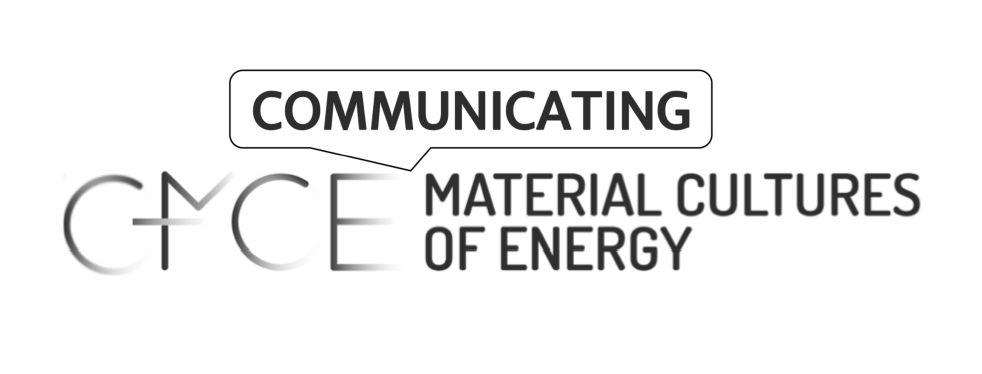activities
Second Knowledge Exchange Session: Visual Communication

The theme of this session was visual communication: how does visual media affect conversations with the public about energy? The first speaker to address this question was Ellie Swinbank from the National Museum of Scotland. Ellie spoke about the Museum’s 2017 exhibition, Age of Oil, which was the result of a partnership with the Scottish artist Sue Jane Taylor. The exhibition aimed to connect visitors to the North Sea oil and gas industry – an industry that fuels the vast majority of Scotland’s activities, but which often seems strange, alien, and far away to energy users. Concentrating on the ongoing decommissioning process, the exhibition used visual media (including drawings, artefacts, and silent film) to foster a more human and personal connection to the industry, the people who work within it, and their changing future.
Ellie spoke about some of the challenges encountered in the project: heritage and oil industries often have different ideas about objects’ significance and the scale and complexity of the industry’s infrastructure make it difficult to represent in museum collections. Sue Jane Taylor’s work and other visual media helped to overcome this latter challenge, putting isolated parts of the industry’s machinery into a more comprehensible and engaging explanatory context: for example, the silent film demonstrated how a flare tip in the Museum’s stores worked, how it was dismantled, and the journey it took to reach the Museum’s collection. In the discussion, we talked about the value of silence: did it make the visual focus more powerful, or would sound have complemented and explained the footage better? We also discussed the difficulty of museums addressing contentious energy-related issues in a non-polemical way: Ellie stressed that the exhibition aimed to create a forum for discussion without telling visitors what to think.
The next talk, by Enrico Costanza from the UCL Interaction Centre, took a different approach to the visual. Enrico discussed ‘Figure Energy’, a project aimed at exploring ways of visualising energy consumption in domestic and technological settings. He discussed a prototype display trialled in 12 homes: instead of focusing on real time consumption (as many devices do), this display focused on historical data and how energy was used over the course of the day. The system promoted reflection amongst users by encouraging them to annotate their energy consumption peaks. Changing the display also enabled users to represent their energy use by activity: different sized boxes on the display represented the different proportions of energy consumed. Feedback from participants found that this encouraged users to relate energy consumption to particular activities (and not just particular appliances). The users also engaged with the idea of annotating – and reflecting upon – their own consumption peaks.
The second system Enrico discussed was a temperature calendar: this heat map – which was trialled in non-domestic buildings – helped companies and council buildings to see that they were sometimes using energy by mistake: for instance, heating was left on Saturdays. Enrico highlighted that this type of overuse is not often discussed; instead, academic literature and public communication tends to focus on energy consumption in relation to convenience. The map was also found to have other benefits when it was trialled in five public libraries; displayed in an accessible place for staff over three weeks, the temperature map encouraged library employees to comply with the council’s temperature policy. It therefore promoted positive action by relating abstract guidelines to the concrete everyday world; it mediated a policy which had already been communicated to staff. This made it different to a lot of other system displays which try to bring about behaviour change directly.
The next speaker, Julie Goodhew, addressed similar themes to Enrico. She spoke specifically about the eViz project, a multi-centre study aimed at reducing energy demand by transforming people’s understanding of energy. The visual was found to be central to this. Julie discussed a study on energy-related communication where only some of the participants were shown thermal images of houses; those who saw images were five times more likely to take one energy-saving action in the next year than those who did not see any images. Subsequent studies undertaken by the project built upon these findings: those who saw a thermal image were eight times more likely to install draught proofing than those who did not. The team also found that those who saw a thermal image of their own home remembered it and thought about their energy consumption more frequently than those who saw a thermal image of a generic home and those who received a text-based message only. This showed the benefits of personalisation in visual communication.
A fourth study revealed, however, that the medium by which the visual image was delivered affected its efficacy: a mail-drop scheme offering government grants for energy efficient upgrades did not find that including thermal images in the letter led to a high response rate: in total only 77 people responded to 4000 letters. This showed that there is a still a large part of the population who are hard to engage in energy-related topics and that letters are not the most efficient way of reaching people. In the discussion, we also considered the trust-related issues surrounding images: the public need to be sure that images used in communications are authentic, come from reliable sources, and are not misused.
When used correctly, however, visual media can be an effective way of building positive and trusting relations with customers. This was demonstrated by Jonathan Morgan, the external communications manager at Electricity North West, who discussed three different case studies. The first, the Spark of Life project, was an exhibition on electricity at Manchester’s Science and Industry Museum; it was sponsored by Electricity North West. Like the Age of Oil, the exhibition used artwork to bring to life hard-to-visualise aspects of the energy system such as underground networks of electricity cables. Visitors enjoyed the way the exhibition situated this seemingly impersonal network in relation to their everyday environment; it showed them what an important support it was to their daily routines.
This was also the aim of the second case study, a public engagement project surrounding the implementation of a smart network management system. The film presented the restructure as a dramatic, forward-thinking change with exciting everyday benefits for the energy users who are (in part) funding it. Jonathan stressed that it was important to show accountability to these customers. This led onto the third case study: the company’s use of images on social media during the Lancaster floods. Sharing images of flooded power stations was found to promote a much more understanding response from those without power than text-based communication. Once again, visual media stimulated trust, sympathy and engagement by enabling users to imagine the distant, unfamiliar or intangible – in this instance, this was a flooded power station and the vast amount of labour needed to repair it.
The final presentation by Greg Lynall brought us back to the museum space with which Ellie’s talk opened the session. Greg discussed ‘Made from Light’, a pop-up exhibition at the Tate Liverpool, which aimed to explore renewable energy through the research of arts and science experts. There was a strong interactive element: visitors could leave comments, questions and responses around the information and research displayed. The aim was to facilitate dialogue without placing the arts and sciences within a hierarchy. The exhibition also showcased the importance of comedy, satire, shock and whimsy in engaging people with energy: satirical cartoons and mock plans for fantastic machines proved effective at stimulating interest and discussion. This shows that the visual alone is not enough; it needs to be used in careful, creative and thought-provoking ways if it is to transform understandings of energy and its various industries as overly complex, tedious or irrelevant to everyday lives.
Written by Hannah Bower





